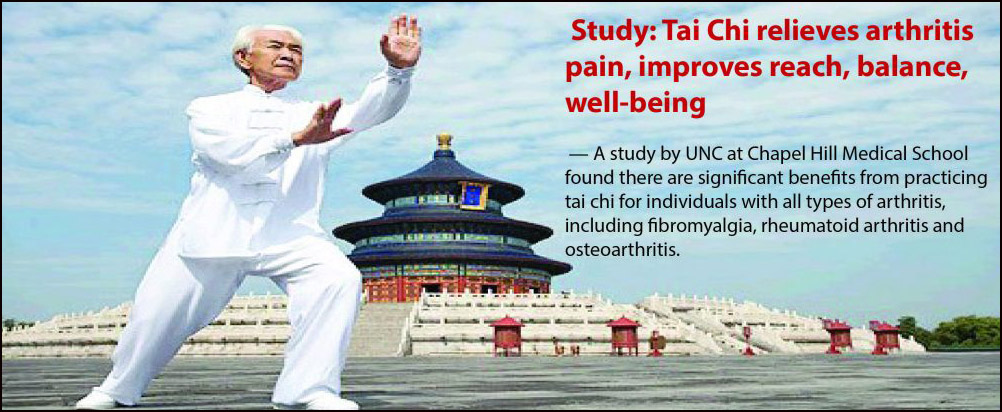
Study:
Tai Chi relieves arthritis pain, improves reach, balance and well-being
Tai Chi originated in ancient China thousands of years ago and is now practiced throughout the world my millions of practitioners. It is both a martial art and a form of “movement meditation”. There are many styles and forms of tai chi. The 5 major styles are Wu, Chen, Yang, Wu, and Sun. Each style possesses different characteristics but they all share the same essential principles.
The essential principles include: focus on mind and body connection, breathe is unified with movement, generating internal qi, mindfulness, relaxed posture, and a calm and serene mind. Tai chi is used to cultivate the qi or life energy within us to flow smoothly and powerfully throughout the body. Total harmony of the inner and outer self comes from the integration of mind and body, empowered by healthy qi from the practice of tai chi.
Although the Chinese have long known the health benefits of a tai chi practice, western medicine is increasingly discovering the medical healths benefits through evidence based research. A study by UNC at Chapel Hill Medical School found there are significant health benefits from tai chi for individuals of all types of arthritis, including fibromyalgia, rheumatoid arthritis and osteoarthritis. According to the study, the participants showed improvement in pain levels, fatigue, stiffness and general sense of well-being. Their ability to reach while maintaining balance also improved, said Leigh Callahan, PhD, the study’s lead author, associate professor at the UNC at Chapel Hill School of Medicine.
“Our study shows there are significant benefits of tai chi practice for individuals with all types of arthritis, including fibromyalgia, rheumatoid arthritis and osteoarthritis,” Callahan said. In the study, 343 participants were randomly assigned into two groups. The experimental group received an 8-week, bi-weekly tai chi course, while the other group was a delayed control group. All participants received baseline and 8-week follow-up evaluations, after which the control group also received the tai chi course.
Findings:
At the end of the eight weeks the experimental group showed improvements in paint fatigue, stiffness, improved reach or balance, and an increased sense of well-being.
References:
J Aging Phys Act. 2016 Jan;24(1):101-10. Don: 10.1123/japa.2014-0211. Epub 2015 Jun 18
